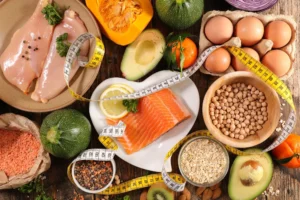
A healthy weight loss plan emphasizes eating nutritious food and engaging in other lifestyle practices that lead to long-term results rather than short-term “diets”. The key is making these activities part of your regular routine rather than treating them as temporary diets that you can go on and off of.
Eat regularly but avoid overeating. Set a reminder for each meal and snack, sit down to eat, take time chewing slowly, and savor each bite!
1. Eat Right
Eating healthily and becoming active are at the core of any effective weight loss plan. Concentrating on adopting sustainable behaviors over time will prove more successful than making sudden big changes, like cutting out carbs or going gluten-free.
Focus on eating whole foods and limit processed meals that tend to be high in fat, sugar and sodium content. Include lean proteins, fruits and vegetables, whole grains, low-fat dairy and healthy fat sources like avocados, olive oil and nut butters in your diet for best results.
Try eating five to six smaller meals throughout the day to help control hunger and appetite. Eating slowly and mindfully is also key; taking note of flavor profiles while listening for signals when your hunger levels have been met so you know when to stop eating.
Avoid diets promising quick weight loss as these are often unhealthy and ineffective. Eating too few calories could result in muscle atrophy, leading to rapid fat loss as well. Instead, follow a balanced diet which includes the appropriate amounts of every nutrient.
2. Get Moving
Diet isn’t the only factor when it comes to healthy weight loss; exercise also plays an essential role. No need to join a gym or run marathons; aim to do 150 minutes of moderate intensity aerobic exercise each week (such as brisk walking). Combining diet changes and physical activity tends to work more effectively than either one alone.
Increase your movement throughout your day by getting off of public transportation early and walking the remaining distance to work; standing during phone calls in the office and when speaking with friends; or turning everyday household tasks, like vacuuming or washing the car into exercises.
Try to limit screen time to two hours each day and take physical actions while watching television such as marching in place or swinging your arms. March in place or swing your arms while watching, and dance along to your favorite songs (dancing can burn 300 calories an hour!). A fitness tracker or smartphone app will keep you motivated and allow you to see progress.
3. Cut Back on Calories
Limiting calories is one of the key steps towards sustainable weight loss, including selecting foods with lower amounts of fat and carbs, while cutting back on sugary drinks, processed treats like doughnuts or cookies, and fried snacks.
Your daily energy requirements depend on factors like height, weight and activity level. Visit MyPlate Plan from USDA for assistance to see how many calories your body requires daily to stay at its current weight.
Eating a diet rich in fiber can help you feel full without taking in too many calories. Try to increase consumption of non-starchy vegetables, beans and whole grains while cutting back on fatty and sugary treats.
Maintaining a large calorie deficit over an extended period can be challenging, so try starting off slowly by gradually building up more vigorous exercises, such as running or gardening. Eating smaller meals throughout the day instead of one big one may also help.
4. Stay Hydrated
As you strive to lose weight, drinking enough water is a critical step. Your body contains approximately 60% water; dehydration can significantly diminish both mental and physical performance – even mild dehydration can impair cognition, cause headaches and alter muscle function. Drinking sufficient fluids also helps regulate temperature while preventing constipation.
Though water remains the optimal hydration solution, other beverages can help meet your hydration goals such as fruit- and vegetable-based juices, low-calorie coffee or herbal tea. Just be wary not to drink too many caffeinated drinks as caffeine stimulates urine production which can cause dehydration.
To meet your hydration goal, set an intention to drink water at regular intervals throughout the day – for instance when waking up, at breakfast, lunch and dinner and before and after exercising. Sipping on water during meals may help decrease appetite while encouraging mindful eating – key components to long-term weight loss success. Replacing high-calorie sodas with water may reduce caloric intake further and some studies have demonstrated that women who switched out their sugary beverages for water lost more weight while on weight loss programs than those who didn’t.
5. Eat More Fruits and Vegetables
Fruits and vegetables contain low calories but are full of fibre that makes you feel full quickly. Eating more of these nutritious foods may help control appetite while decreasing unhealthy food consumption and managing your weight more effectively.
Reach for at least two portions of fruits and vegetables at each meal, whether fresh, frozen, canned or dried varieties. When possible, opt for colourful options as these provide more nutrients.
Starchy foods such as potatoes, bread, rice and pasta should make up no more than one-third of your plate. When selecting such meals, always opt for wholegrain varieties as these contain less fat.
Sugary foods and drinks contain empty calories that should be limited. Aim to limit added sugars to no more than 10 percent of your total daily caloric intake – such as soda, fruit juices and smoothies as well as syrups or ketchup – with no sweeteners added at all if possible, or pair these foods with low-fat dressings and sauces instead.




